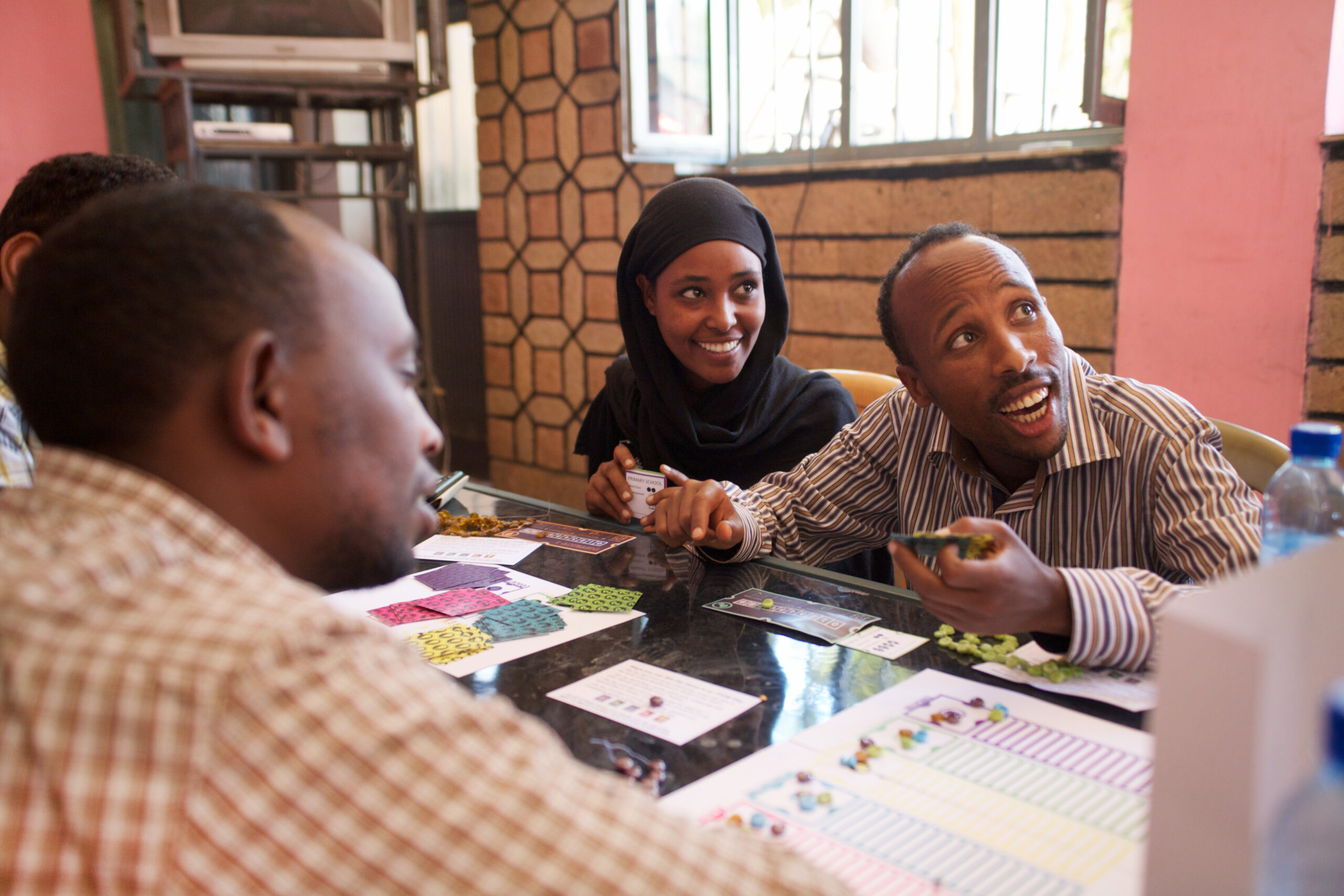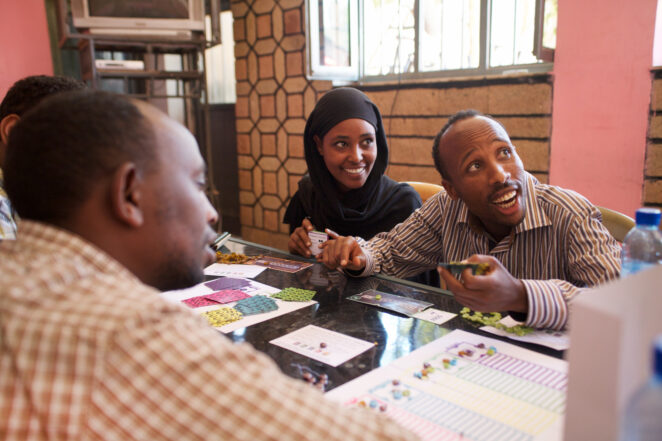Case-study /
Planning for the future and adapting to climate change in Ethiopia – Lessons from ACCRA


Government officials and civil society members playing the ACCRA game in Gemechis Woreda, Ethiopia
Adaptation context
85% of Ethiopians are dependent on rain for their livelihoods, either as smallholder farmers or pastoralists, meaning that most of these 66 million people are highly vulnerable to the frequently occurring drought and floods that affect the country.
Although climate variability is not new to Ethiopia, ever-decreasing plot sizes and natural resource degradation have made livelihoods more tenuous. At the same time, communities report that in recent years, the weather has been more unpredictable and droughts more frequent. This has a particularly significant impact on women who travel ever-greater distances to collect water and firewood, as well as filling the gap left by failed agriculture with small scale trading activities.
Climate change is a key concern for the Government of Ethiopia. Meles Zenawi, the Prime Minister of Ethiopia has been vocal in calling for emissions cuts and adaptation finance in the international climate negotiations. In addition, domestically a number of social protection and disaster risk management programmes are underway, including the largest safety net in Africa – the Productive Safety Net Programme (PSNP). However, there is still much to be done – in particular identifying how best to support communities to adapt, and improving coordination between relevant stakeholders.
The ACCRA Approach – Flexible and Forward-Looking Decision Making
ACCRA uses a set of research and capacity building tools to promote pro-poor and participatory climate change adaptation (CCA) and disaster risk reduction (DRR) in planning processes. Through supporting the government and engaging local communities, ACCRA seeks to help woredas produce better plans in the face of future change and uncertainty. In turn, ACCRA supports the scaling up of its activities across the country and influence on national policy.
ACCRA’s earlier work showed that policymakers face difficult trade-offs in planning for a changing and uncertain future.Yet many development actors continue to plan forthe near-term, with little room for manoeuvre or contingency. ACCRA therefore chose to focus on one specific characteristic of adaptive capacity in order to help decision makers and planners to better prepare themselves for the future: Flexible and Forward-Looking Decision Making (FFDM).
In collaboration with the abaci Partnership and the Red Cross/Red Crescent Climate Centre, a game-enabled reflection approach was tailored for woreda- level planners and developed into a two- to three-day workshop. This was held in Gemechis woreda in West Hararghe zone of Oromia region. Key stakeholders in government and civil society were trained as facilitators. At the same time, ACCRA undertook research to evaluate the effectiveness of this approach in promoting FFDM with woreda and zonal development planners in Ethiopia.
Capacity building for development planning
ACCRA’s strong partnership with DRMFSS has meant that ACCRA’s participatory approach and evidence from pilot projects is being integrated into the roll-out of national disaster planning. These elements, as well as ACCRA’s Local Adaptive Capacity Framework have been integrated into woreda level DRR planning. This has included development of guidelines, Training of Trainers and support to woredas to develop woreda DRR and Contingency Plans. Through this work, ACCRA is ensuring national and local level planners take into account climate change and other future trends into DRR planning.
ACCRA is working with MoEF to support the capacity of woredas and regions to put national development plans into practice.The Climate Resilient Green Economy (CRGE) is Ethiopia’s development vision to gain middle-income status by 2025 through climate resilient green growth. ACCRA is assisting with the design of woreda level CRGE investment plans. The accompanying investment planning manual is being piloted to test the approach. ACCRA seeks to bring input from the local level into regional and national level planning and implementation of CRGE.
ACCRA is also proactively engaging key government and civil society actors to see benefits of linking DRR and CCA.Using a unique gradual training approach, over six months stakeholders are being trained and coached on how to mainstream DRR and CCA into processes, policy, programmes and practice.
Lessons learned from ACCRA research and capacity building
Below are some of our key findings from 4 years of research and capacity building in Ethiopia:
Local and national plans are focused on the near-term. They often fail to take a long-term perspective and recognise future change and uncertainty.Decision making, even under normal circumstances is a tough task. Add climate change-related uncertainties to it and it becomes even harder. Therefore, district-level decision makers need tools that help them deal with complexity in a flexible manner and allow them to consider potential future threats – climate-related and otherwise.
Although communicating concepts such as uncertainty and FFDM can be difficult, a game-enabled reflection approach can help in communicating FFDM to development practitioners. But changing perceptions and institutional structures is a gradual process, requiring continuing support from development partners.
Ensuring political buy-in is key for promoting FFDM and adaptation. Woreda and zonal officials recognised that they do have some space for putting the principles of FFDM into practice, even within strict centrally- defined planning processes. For example, one workshop participant described the following local activities:
‘[After the workshop] we increased involvement of the community in the identification and prioritisation of district problems. In addition, the planning process now considers future challenges and problems in anticipation. For example, the district’s emergency plan was previously prepared based on prevalent disaster risks – after the disasters occurred. But we now use weather forecast information, and preparation of the emergency plan is carried out not only based on what is prevailing but also in anticipation of potential hazards.’ (Zonal Official, West Hararghe, 2013)
However, opportunities like these quickly reach their limits unless active support and buy-in from political leaders is guaranteed.
Opportunities do exist to do things differently. Recognising inherent limitations in the rigidity of policy cycles and planning processes in Ethiopia, there is always some flexibility. Even when targets are handed down from central government, woreda planners can often decide the specific modalities of implementation.
Recommendations
To enhance adaptive capacity and promote FFDM, many different actors will need to take action. ACCRA recommends that the following activities be instigated:
Woreda governments should exploit opportunities to promote FFDM within constraints by:
- Integrating CCA and DRR into implementation ofplans. For example, woredas are required to investin natural resource management and afforestation. Where and how this is implemented is largely up to the district administration. If planned effectively, efforts to promote afforestation can both meet allocated targetsas well as reduce the risk of landslide and damage toinfrastructure through well-informed site selection.
- Seeking information and advice from external sourcesfor more informed decision-making, whether from central line ministries, national and international NGOs or private sector actors. Examples may include the use and uptake of seasonal or decadal climate information from the National Metrological Agency (NMA) or the sharing of experiences in promoting climate smart agriculture among development partners. .
- Collaborating across and within different sectors and districts to pool resources and draw up contingency plans. In West Hararghe Zone, given its exposure to climate extremes, contingency plans are increasingly elaborated that allow quick reaction in the case of a disaster by relevant government agencies and NGOs, including deployment of funds for emergency measure.
- Reflecting on where the woreda aims to be on time horizons beyond the traditional three- to five-year planning cycles.
- MoA and MoEF should encourage woredas to developlonger-term strategies that incorporate principles of FFDM.
- Woredas should be given freedom to define and shape their own development targets based on local needs and priorities. Currently in Ethiopia, a typical woreda sector budget allocates less than 10% to capital investments, with more than 90% allocated to recurrent costs, of which the majority is allocated for salaries, which does not promote decision-making at the woreda level.
- Greater exchange and eventually coordination across sectors and ministries, including DRMFSS, MoA, MoEF and NMA, and between different levels of government should be promoted.
- Mobilising technical and financial resources to promote ongoing dialogue around FFDM.
- Promoting collaboration across sectoral boundaries and bringing together stakeholders that would not normally collaborate together.
- Sharing learning and practical experience.
Donors and multilateral agencies need to ensure they are responsive to changing priorities and unforeseen circumstances by:
- Enabling greater flexibility by moving away from short-term target-based thinking (e.g. payment for results) to use their funding mechanisms to promote beneficial outcomes in the longer term.
- Adjusting funding timescales to provide incentives to consider and promote longer-term objectives within projects and programmes.
- Promoting planning reform processes which recognise the need for local level adaptive planning.
